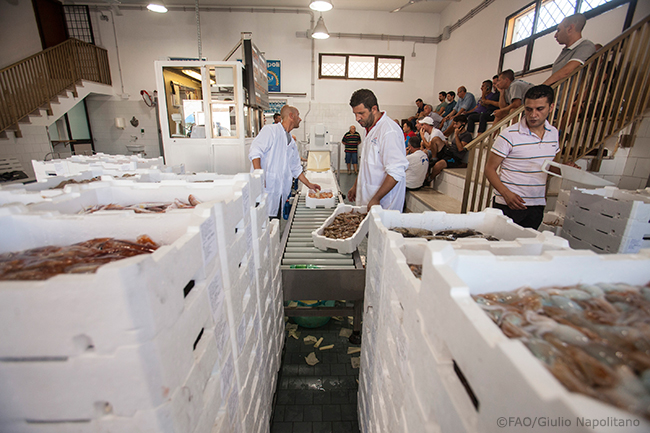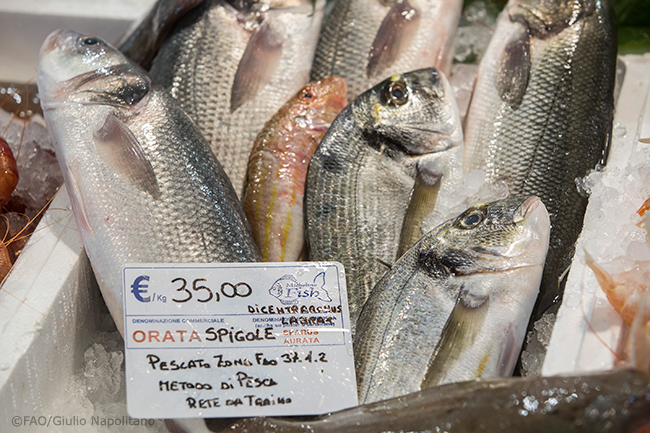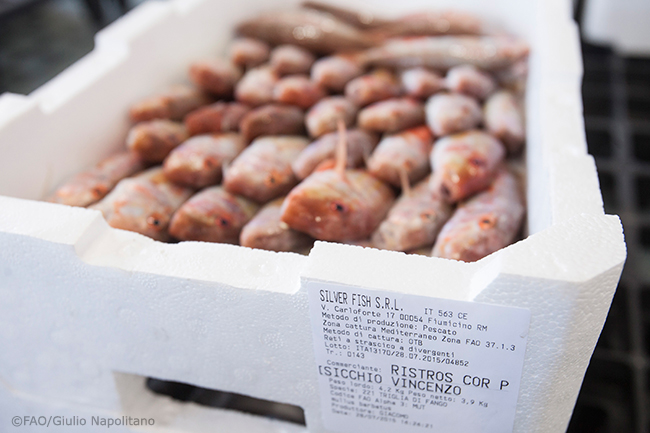FAO at your local fish market
New posters help consumers trace their catch

Fish boats entering the Fiumicino harbor in Fiumicino, Italy.
©Photo: ©FAO/Giulio Napolitano
2 October 2015, Rome -- Permesso! (Pardon me!) a man yells as he pushes a large cart with stacked boxes of fresh seafood through a crowd gathered on the dock of the Fiumicino fish harbor, half an hour outside of Rome. One trawler after another dock in quick succession to unload the spoils of the day's fishing expedition - a choreographed ballet of men passing crates of shrimp, soles, sardines and squid from the boat onto shore.
They are the fruits of FAO Major Fishing Area 37.1, also known as the Western Mediterranean, which covers the Balearic Islands, the Gulf of Lions, and Sardinia.
The majority of boxes is carted straight away to the nearby auction market where they will be labeled, and restaurants and traders will bid on them.
Smaller quantities are sold right there on the dock to the local in-crowd, who time their arrival with that of the boats to get the freshest of Mediterranean catch before it goes to market.
But for most consumers, such a direct connection to the seafood they eat is rare if not impossible to have -- this makes food labeling all the more important.
 |
More transparency for consumers
Area 37 is one of 19 Major Fishing Areas displayed on a new set of posters that FAO is making available to retailers around the world who are keen to respond to increasing consumer demand for better information, as well as evolving labeling standards set by governments.
This includes the European Union, which has recently adopted new labeling standards that make it mandatory for all fishmongers to provide information on the fishing method used and the Major Fishing Areas their seafood was caught.
Traceability is important both for food quality and safety, and for sustainability reasons, says Audun Lem, Deputy Director of the Policy and Economics Division in FAO's Fisheries and Aquaculture Department. "It helps to ensure that the seafood we eat is healthy and legal and that fish stocks are maintained for generations to come," according to Lem.
"One of the most positive changes we've seen in the last 20 years is the amount of interest the modern consumer now takes in the food he or she eats," he says, pointing to the milestone FAO Code of Conduct for Responsible Fisheries that is celebrating its 20th anniversary this year.
This means detailed labeling is good for business, too.
At Michelino's fish market and restaurant, some 20 Km outside of the Fiumicino harbor, customers browse by neatly arranged displays of seafood.
"Seabass, 35 euro per kilo, fishing method: trawling, FAO fishing area 37.1.2," a sign says -- a look at the new FAO poster behind the counter shows these particular fish were caught in the Gulf of Lions.
 |
This type of labeling system, which allows consumers to make safe and sustainable choices, has stimulated the consumption of fish products, says Ruggero Urbani, a fisheries consultant with FAO and a fish inspector with the Italian Health Agency.
"Previously, the fish was sold without any indication - and so fears around freshness and fears of one product being sold or passed off as another used to temper consumption," according to Urbani.
Improved labeling systems, in turn, help to build trust in increasingly vocal and informed consumers. And in the age of the internet, those don't let themselves be led by the nose, says Michelino.
"Customers these days inform themselves a little bit about everything, and sometimes they know more than we do - so it's very hard to fool them."
Fish sellers around the world can download the new posters in high resolution format here.
 |
Contact
Kim-Jenna Jurriaans FAO Media Relations (Rome) (+39) 06 570 54277 [email protected]
